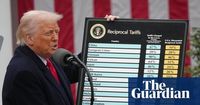The Trump administration’s trade policies, particularly its aggressive use of tariffs, have sent ripples through global markets, diplomatic circles, and the day-to-day operations of businesses large and small. As of August 20, 2025, the United States finds itself at a pivotal moment, with tariff revenues surging, international partners bristling, and the world’s trade lanes undergoing a dramatic shift.
US Treasury Secretary Scott Bessent, in a recent Fox News interview, summed up the administration’s stance: the current tariff setup with China is “working pretty well.” Bessent emphasized that China remains the largest single source of tariff revenue for the US, a point underscored in his subsequent conversation with CNBC. There, Bessent revised his earlier forecast, stating, “I’ve been saying that tariff revenue could be $300 billion this year. I’m going to have to revise that up substantially.” He clarified that the windfall would go toward paying down the federal debt, not toward rebate checks for Americans.
This approach has drawn attention from credit rating agencies and market watchers alike. On Monday, August 18, S&P Global Ratings reaffirmed the US’s AA+ long-term credit rating with a stable outlook, noting that the influx of tariff revenues would help offset the fiscal blow from President Trump’s recent tax and spending bills. Yet, the agency’s confidence comes despite the market volatility and strained trade ties that have followed Trump’s sweeping tariff measures.
The global trade landscape is not standing still. Mike Parra, CEO of DHL Express Europe, told Bloomberg Television in London that he is witnessing a real-time shift in goods movement as a direct result of US tariffs. “China-US was a big trade lane for us, and Asia-Pacific to the US was a big trade lane for us,” Parra explained. “Now that’s shifted from China and Asia-Pacific to Europe.” For logistics giants like DHL, these changes are more than theoretical—they’re reshaping the very routes that goods take around the world.
Meanwhile, the Trump administration’s use of tariffs has moved far beyond traditional economic policy. According to reporting by The Guardian, tariffs are now wielded as political levers. President Trump recently threatened to slap an additional 25% tariff on India, which would bring the total to a staggering 50%—matching the highest levies imposed on any country, including Brazil. This escalation comes after five rounds of fruitless trade talks, with India resisting US demands to open its agriculture and dairy sectors. Further complicating matters, negotiations scheduled for the week of August 18 were abruptly canceled after Trump demanded that India cease purchasing Russian oil, which accounts for roughly 35% of India’s total supply.
The rationale for such tariffs appears to be shifting. Dr. Stuart Rollo of the Centre for International Security Studies at the University of Sydney observed, “Tariffs have a very specific purpose of protecting domestic industry from competition. That’s not really what this is about … It’s kind of pivoted to a tool of geopolitical compulsion.” Trump himself has acknowledged the political motivations behind recent tariffs, tying Canada’s 35% tariff to its recognition of Palestinian statehood and linking the 50% tariff on Brazil to the trial of former President Jair Bolsonaro, who stands accused of plotting a military coup after his 2022 election defeat.
Peter Navarro, Trump’s top trade adviser, has even coined a new term for these measures: “national security tariffs.” Democratic Senator Chris Murphy, writing in the Financial Times, was more blunt, describing the tariffs as “means to compel loyalty to the president.” Rollo added, “It’s a way of the United States to compel as much of the world as possible into realignment with its global leadership at a time when its actual weight and gravity is diminishing.”
For many in India, the US’s insistence on halting Russian oil imports seems incoherent and could have unintended consequences. Devashish Mitra, a professor of economics at Syracuse University, remarked, “India did consider the US an ally. It was a country that the US was relying on as a counter to China in that region. So it had a huge geopolitical importance, but it doesn’t seem like Trump values any of that.” Recent diplomatic moves—China’s foreign minister visiting Delhi and Indian Prime Minister Modi planning a trip to Shanghai—highlight a tightening of ties among BRICS nations (Brazil, Russia, India, China, and South Africa), which together account for 40% of global GDP. Experts suggest this is a direct response to the US’s aggressive trade posture.
The Trump administration’s reliance on tariffs comes as other tools of foreign policy have been sidelined. Mass firings at the State Department and deep cuts to USAID’s foreign assistance programs have left tariffs as the administration’s primary instrument of international engagement. As Rollo put it, tariffs have “come to replace diplomacy.”
Back at home, the impact of tariffs is about to hit Main Street. Several major retailers—including Walmart, Target, Home Depot, Lowe’s, TJX Companies (the parent of TJ Maxx), and Ross Stores—are set to report earnings this week, offering the first real glimpse into how tariffs are affecting their bottom lines. The administration has urged these retailers, with a particular focus on Walmart, not to pass tariff costs on to consumers through higher prices. But that may be easier said than done, as supply chains adjust and costs mount.
Economists are watching closely for signs of broader economic fallout. Justin Begley, an economist at Moody’s Analytics, told USA Today that while Trump’s economic policies are unlikely to trigger a recession or stagflation, they are likely to slow growth and push up inflation. “The economy isn’t in stagflation yet,” Begley said, “but it’s edging that way.”
Internationally, the US’s assertive trade moves have prompted pushback. Brazil, for example, has formally rejected the legitimacy of a US trade investigation launched in July under Section 301 of the 1974 Trade Act, which is examining whether Brazil’s digital trade and tariff policies unfairly harm US businesses. Brazil’s finance minister, Fernando Haddad, stated that resolving the tariff dispute will depend on Washington’s willingness to engage, signaling that the impasse may persist unless the US shows flexibility.
Looking ahead, the world’s eyes are on upcoming trade negotiations with Canada, Mexico, and China. Each of these talks will test whether tariffs can deliver the stability and leverage the Trump administration seeks, or whether they will deepen rifts and drive further realignment among America’s global competitors.
As the dust settles, it’s clear that the Trump administration’s trade war has become more than a matter of economics. It’s a high-stakes game of global politics, with tariffs serving as both shield and sword in a rapidly changing world.





